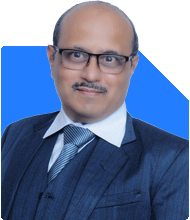Worried Dad Seeking Investment Strategies for Kids' Education and Inflation amidst Tight Finances
Ramalingam Kalirajan |10893 Answers |Ask -Follow
Mutual Funds, Financial Planning Expert - Answered on Aug 10, 2024
He has an MBA in finance from the University of Madras and is a certified financial planner.
He is the director and chief financial planner at Holistic Investment, a Chennai-based firm that offers financial planning and wealth management advice.... more

Hi Sir, Currently I'm working as Senior Engineer(36) and take home salary is 1 lac/month, my wife(29) working in a accounting services firm with a salary of 15k month. we have a outstanding home loan of 33 lacs. 2 kids studying in JKG and play school. Invested 5k per/month in SIP, 6k in Gold, LIC and Savings of 5Lacs. How to plan the investment for Children's Higher Education and Manage inflation in future,. Please share the ideas/roadmap to achieve the goals.
Investment Strategy for Children’s Higher Education
1. Estimate Future Education Costs
Inflation Consideration: Education costs rise faster than general inflation, often around 8-10% annually. Project the future cost of your children's higher education by factoring in this inflation rate.
Time Horizon: Your children are currently in JKG and play school. You have roughly 10-15 years before these major expenses begin. This gives you a good time horizon to grow your investments.
2. Increase SIP Investments
Enhance Equity Exposure: Given the long-term horizon, consider increasing your monthly SIP investment. Equity mutual funds can offer higher returns over a 10-15 year period, helping you build a substantial corpus. Start by gradually increasing your SIPs by Rs. 2,000-3,000 every year, or whenever your income increases.
Diversify Across Funds: Consider diversifying your SIPs into different types of equity mutual funds like large-cap, mid-cap, and flexi-cap funds. This diversification will balance risk and growth potential, aligning with your long-term goals.
3. Create a Dedicated Education Fund
Start a New SIP: If possible, start a separate SIP dedicated to your children's education. Even an additional Rs. 2,000-3,000 per month in a balanced or hybrid mutual fund could significantly contribute to their education expenses.
Utilize Existing Savings: You have Rs. 5 lakhs in savings. Consider allocating a portion of this towards a long-term investment like a Public Provident Fund (PPF) or an equity mutual fund with a proven track record. This can serve as a dedicated fund for future education expenses.
Managing Inflation and Future Financial Goals
1. Regularly Increase Investments
Step-Up SIPs: Each year, as your income increases, boost your SIP contributions. For example, if your salary increases by 5%, consider increasing your SIPs by the same percentage. This method helps combat inflation and accelerates wealth creation.
2. Gold Investment Strategy
Review Gold Investments: While gold is a good hedge against inflation, its long-term returns can be lower than equities. Consider capping your gold investment at 10-15% of your total portfolio. You might redirect a portion of this investment into higher-growth equity mutual funds.
3. Home Loan Management
Prepay Home Loan: Given the interest on your home loan, consider using part of your Rs. 5 lakh savings or a portion of your income to make periodic prepayments. Reducing the principal can significantly decrease the interest burden and free up more money for investments.
Tax Benefits: Remember to take full advantage of the tax deductions available on home loan interest under Section 24(b) and principal repayment under Section 80C.
Securing Your Financial Future
1. Emergency Fund
Build a Cushion: Ensure you have an emergency fund that covers 6-12 months of living expenses. This fund should be kept in liquid assets like a savings account or short-term debt funds. This provides security against unexpected expenses without disrupting your investment plan.
2. Review Insurance Coverage
Adequate Life Insurance: Ensure that you and your wife have adequate life insurance coverage. Your LIC policy is a good start, but make sure the total coverage is sufficient to cover outstanding liabilities like your home loan and provide for your family in case of any eventuality.
Health Insurance: With young children, comprehensive health insurance for the entire family is essential. This helps manage unexpected medical expenses, ensuring your savings and investments remain intact.
Long-Term Wealth Creation
1. PPF/NPS Contributions
Secure and Long-Term: Consider contributing to PPF or NPS for a portion of your long-term savings. Both offer tax benefits and are secure options, with PPF being particularly useful for long-term goals like retirement or children’s education.
2. Diversify with Mutual Funds
Balanced Portfolio: As your investment capacity grows, consider spreading your investments across different asset classes, including equity, debt, and gold. This reduces risk and ensures steady growth.
3. Regular Portfolio Review
Annual Check-Ups: Regularly review your investment portfolio to ensure it aligns with your goals. Adjust your asset allocation as needed based on market conditions and your risk tolerance.
Final Thoughts
By systematically increasing your investments, diversifying across asset classes, and strategically managing your home loan, you can effectively plan for your children’s higher education and manage inflation. Regular reviews and adjustments, along with maintaining a strong emergency fund, will ensure financial stability and growth for your family.
Best Regards,
K. Ramalingam, MBA, CFP,
Chief Financial Planner,
www.holisticinvestment.in
You may like to see similar questions and answers below
Ramalingam Kalirajan |10893 Answers |Ask -Follow
Mutual Funds, Financial Planning Expert - Answered on Jul 04, 2024
Ramalingam Kalirajan |10893 Answers |Ask -Follow
Mutual Funds, Financial Planning Expert - Answered on Jul 23, 2024
Nitin Narkhede |113 Answers |Ask -Follow
MF, PF Expert - Answered on Dec 15, 2025
Nitin Narkhede |113 Answers |Ask -Follow
MF, PF Expert - Answered on Dec 15, 2025
Ramalingam Kalirajan |10893 Answers |Ask -Follow
Mutual Funds, Financial Planning Expert - Answered on Dec 15, 2025
Ramalingam Kalirajan |10893 Answers |Ask -Follow
Mutual Funds, Financial Planning Expert - Answered on Dec 15, 2025
Radheshyam Zanwar |6746 Answers |Ask -Follow
MHT-CET, IIT-JEE, NEET-UG Expert - Answered on Dec 15, 2025
Ramalingam Kalirajan |10893 Answers |Ask -Follow
Mutual Funds, Financial Planning Expert - Answered on Dec 15, 2025
Ramalingam Kalirajan |10893 Answers |Ask -Follow
Mutual Funds, Financial Planning Expert - Answered on Dec 15, 2025
Ramalingam Kalirajan |10893 Answers |Ask -Follow
Mutual Funds, Financial Planning Expert - Answered on Dec 15, 2025
Samraat Jadhav |2508 Answers |Ask -Follow
Stock Market Expert - Answered on Dec 15, 2025
Ramalingam Kalirajan |10893 Answers |Ask -Follow
Mutual Funds, Financial Planning Expert - Answered on Dec 15, 2025











.jpg)











